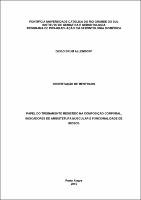| Share record |


|
Please use this identifier to cite or link to this item:
https://tede2.pucrs.br/tede2/handle/tede/6036| Document type: | Dissertação |
| Title: | Papel do treinamento resistido na composição corporal, indicadores de arquitetura muscular e funcionalidade de idosos |
| Author: | Allendorf, Diego Brum  |
| Advisor: | Gottlieb, Maria Gabriela Valle |
| Abstract (native): | Introdução : O processo de envelhecimento pode afetar a massa e força muscular e independência funcional. O declínio do tecido musculoesquelético interfere significativamente na capacidade funcional dos idosos. Porém, a prática regular de treinamento resistido pode evitar e/ou minimizar estes declínios funcionais oriundos do processo de envelhecimento. Objetivo : verificar a associação entre variáveis antropométricas, de espessura de massa muscular e gordura, independência funcional e força muscular em idosos que praticam treinamento resistido (TR) e idosos considerados fisicamente ativos, porém sem praticar o treinamento resistido. Métodos : Estudo transversal com grupo de comparação, observacional e não probabilístico. A amostra foi composta por 114 idosos divididos em dois grupos: grupo TR (GTR): 43 idosos praticantes de TR; grupo fisicamente ativo (GFA): 71 idosos considerados fisicamente ativos. As variáveis coletadas foram: sociodemográficas, antropométricas e funcionalidade. Os instrumentos utilizados foram: fita métrica inelástica, adipômetro, ecógrafo, teste do senta e levanta, dinamômetro de força, AVD, TUG test. A amostra foi ajustada para sexo, idade, renda e escolaridade. Resultados : Encontrou-se diferenças significativas em relação ao sexo, estado civil, renda e escolaridade entre os grupos investigados (p<0,001). Não foram observadas diferenças significativas entre os grupos em relação às variáveis antropométricas (p>0,05) e espessuras musculares (p>0,05). Contudo, idosos do grupo GTR apresentaram uma média menor de tempo de deslocamento no TUG test (6,24±0,86 segundos) em relação ao GFA que apresentou uma média de 11,24±4,26 segundos (p= 0,035). Conclusão : idosos que praticam o TR apresentaram significativamente melhor desempenho no TUG test, que está relacionado com menor risco de quedas e fraturas em idosos. |
| Abstract (english): | Background : The phenomenon of aging can affect muscle mass, muscle strength and functional independence. The decline of musculoskeletal tissue interferes significantly with the functional capacity of the elderly. However, the practice of regular resistance training can prevent and / or minimize these derived functional declines of aging. Objective : to verify the association among anthropometric variables and muscle thickness, functional independence and muscle strength in older adults who practice resistance training and those still physically active, but without practicing resistance training (RT). Method : Sectional study with a comparison group, observational and not probabilistic. The sample consisted of 114 elderly divided into two groups: resistance training group (RTG): 43 elderly individuals practicing RT; physically active group (GFA): 71 elderly considered physically active. The variables were collected: sociodemographic, anthropometric, functional independence and functionality. The instruments used were inelastic tape measure, caliper, ultrasound, test and sit-ups, dynamometer strength, TUG test. The sample was adjusted for sex, age, income and education. Results : Significant differences were found with regard to sex, marital status, income and education between investigated groups (p <0.001). No significant differences were observed between the groups regarding the anthropometric variables (p> 0.05) and muscle thickness (p> 0.05). However, the GTR elderly group had a lower average travel time on the tug test (6.24 ± 0.86 seconds) compared to the GFA which averaged 11.24 ± 4.26 seconds (p = 0.035). Conclusions : TR group elderly had significantly better performance in the TUG test, which is related to less risk of falls and fractures the elderly. |
| Keywords: | MEDICINA GERONTOLOGIA GERIATRIA ANTROPOMETRIA IDOSOS FORÇA MUSCULAR ATIVIDADES MOTORAS EXERCÍCIOS ISOMÉTRICOS |
| CNPQ Knowledge Areas: | CIENCIAS DA SAUDE::MEDICINA |
| Language: | por |
| Country: | Brasil |
| Publisher: | Pontifícia Universidade Católica do Rio Grande do Sul |
| Institution Acronym: | PUCRS |
| Department: | Instituto de Geriatria e Gerontologia |
| Program: | Programa de Pós-Graduação em Gerontologia Biomédica |
| Access type: | Acesso Aberto |
| URI: | http://tede2.pucrs.br/tede2/handle/tede/6036 |
| Issue Date: | 11-Mar-2015 |
| Appears in Collections: | Programa de Pós-Graduação em Gerontologia Biomédica |
Files in This Item:
| File | Description | Size | Format | |
|---|---|---|---|---|
| 469008 - Texto Completo.pdf | Texto Completo | 4.13 MB | Adobe PDF |  Download/Open Preview |
Items in DSpace are protected by copyright, with all rights reserved, unless otherwise indicated.




